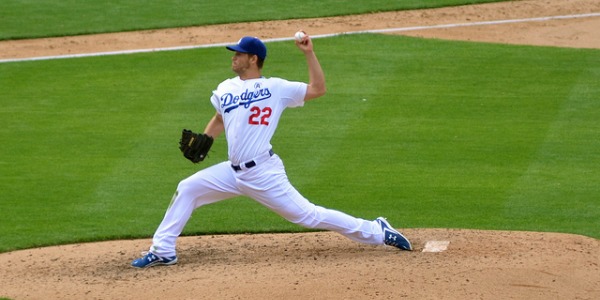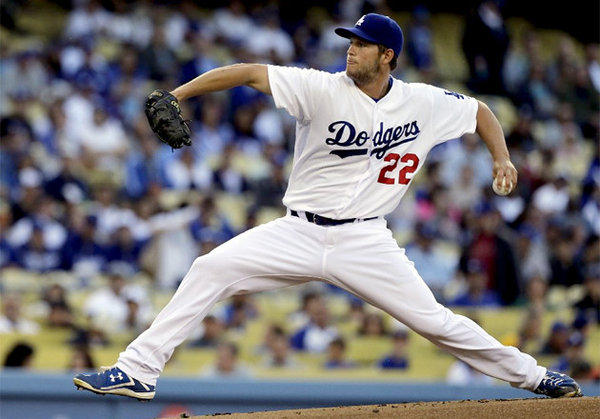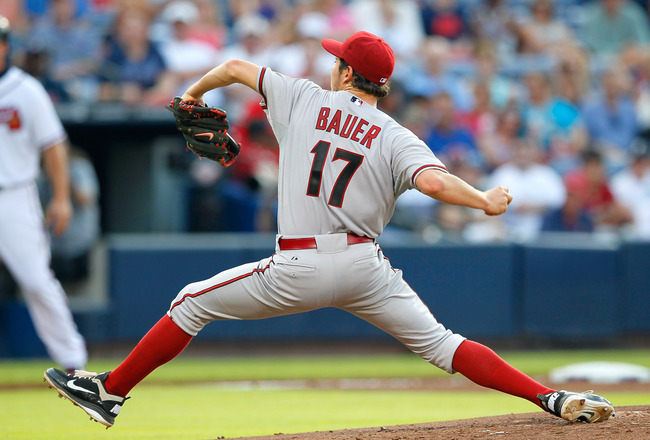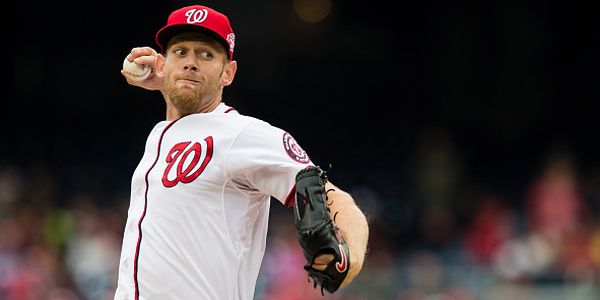2014 Fantasy Baseball: Week Two Musings


The wonderful game of baseball provides a plethora of things to talk about, and those things don’t always tie together very neatly. Instead of trying to force a square peg through a round hole, I’m going to embrace this platform to speak on a variety of wide spanning topics that interest me. Today that means that I’m going to look at the Mets closer situation, the return of Trevor Bauer, and I’m going to tackle the Clayton Kershaw injury.
Closing in Queens
Bobby Parnell made his first relief appearance of the year on Opening Day, and after undergoing successful Tommy John surgery on Tuesday, it is safe to say it was his last appearance for the Mets this year as well. His removal from the closer role has left Jose Valverde to take over the gig. Papa Grande signed a minor league contract in February with an invite to spring training. He earned the primary setup role for the club, a role that didn’t present much in the way of fantasy value. But now that he’s recording saves (one so far in his lone save opportunity) fantasy gamers have to decide if he’s worth rostering or not.
In NL-only formats owners have no choice but to grab every save that is available since there are so few closers to spread across teams. In shallow and medium sized mixed leagues, gamers can be a little pickier and I would advise them to leave Valverde alone. The Big Potato was awful last year with the Tigers, and it took some exceptional home run suppression luck to keep his ERA south of four in 2012. He’s off to a fast start with six strikeouts, just one walk and zero runs allowed in 4.1 innings pitched so far, but his diminished stuff won’t allow him to continue to strike batters out at a high rate.
Valverde’s average fastball velocity has been on the decline every year since peaking at 96.11 mph in 2009. These days Brooks Baseball has his average fourseam fastball velocity at 93.27 mph. The odd thing is, the two-pitch pitcher’s (Valverde throws just a fourseam fastball and a splitter) fastball usage has gone up each year since 2010. With less potent cheddar and more usage, it should come as little surprise that hitters had no problem making contact against him last year. Fangraphs had his zone-contact percentage at 93.3 percent, 6.3 percent higher than the league average. Not missing bats is okay if a pitcher throws a truck load of strikes and keeps the ball on the ground at a high rate, but neither of those things holds true for Valverde.
My guess is someone else ends up leading the Mets in saves this year, perhaps an in-house candidate like Kyle Farnsworth or Vic Black, or maybe a player not on the roster such as free agent Joel Hanrahan (total speculation on my part). Regardless, Valverde simply isn’t worth the risk of taking a blow torch to a team’s ERA or WHIP in anything other than large mixed leagues (14 teams or larger) or NL-only formats. Let him cause headaches for another league member.
Jack Bauer Isn’t the Only Bauer That’s Back
Don’t look now, but Trevor Bauer just might be getting interesting again. He lost a battle for the Indians fifth starter spot to Carlos Carrasco. Carrasco is out of options, so it’s possible that played a hand in the decision, but the former UCLA Bruin didn’t exactly go out and dominate in the spring either. Bauer has made two strong starts this season, one in Triple-A for Columbus, and one on Wednesday in the second game of the Indians double-header.
In his minor league start the usually erratic starter threw 59 of his 96 pitches for strikes (61.5 percent strikes) and walked only two batters in six innings of work while striking out nine and allowing one earned run on two hits. For comparisons sake, Bauer has thrown just 57.1 percent of his pitches for strikes in his brief big league career entering this season and has a minor league walk rate of 4.7 BB/9. One start is just that, one start, but for someone who has had issues with ball four it is encouraging to see Bauer with a good start under his belt in which walks weren’t a problem.
Bauer’s start on Wednesday in the bigs was arguably more impressive given the fact he was facing a major league lineup. He pitched six innings allowing four hits, two runs (one earned and one unearned) with two walks and eight strikeouts. The 23-year old wasn’t exactly efficient racking up 99 pitches in those six innings of work, but it wasn’t because he failed to locate the strike zone since 65 of those pitches were thrown for strikes. ESPN credits Bauer with starting 15 of 25 batters off with a first pitch strike (60 percent first pitch strike rate, or roughly the league average in recent years). Getting ahead is obviously ideal for all pitchers, but with Bauer’s deep arsenal it puts him in a position to dip into the goody bag to put batters away.
Speaking of his pitches, the PITCHf/x data from Bauer’s start today is tantalizing. Much has been made of the young hurler’s unorthodox training regimen and unique mechanics, and there was a lot of noise about him tweaking his mechanics this spring. I’ve anxiously been awaiting a big league appearance from Bauer to see what effect these changes might have on his stuff, and the extremely early take is exciting. Bauer’s average fourseam fastball velocity on Wednesday was 94.79 mph according to Brooks Baseball. That’s up a little more than a full tick from 2012 and 2013. Maybe more impressive than the velocity of his fourseam fastball was Bauer’s willingness to use it.
The third pick in the 2011 MLB Amateur Draft threw his heater 62 times, and nine of them resulted in a whiff. An effective heater should, in theory, help his other stuff play up and aid him on days that one or more of his secondary pitches aren’t working well. Bauer used four other secondary pitches in his big league start, a changeup, curveball, slider, and screwball. Of those four pitches Bauer threw his screwball the least (four times). That’s worth noting because it was the secondary offering he turned to the most frequently in his previous stints in the majors. Is Bauer evolving? He might be, it’s too early to tell, but his strikeout potential is intriguing and Carrasco’s leash might have shortened a bit after Wednesday’s strong showing from Bauer. If nothing else, his stock is up a bit.
Hurt-Shaw
The same can not be said of Kershaw’s stock. What should owners do with the best pitcher in baseball? My advice is to move him in yearly leagues, even knowing he’ll have to be sold at 75 cents on the dollar. On Sunday Night Baseball on ESPN Buster Olney interviewed Kershaw during the Dodgers and Giants game, and the southpaw admitted he doesn’t have a time table for return. Jon Morosi tweeted a quote from Kershaw on Wednesday that his throwing session that day was “definitely a step forward.” This is all fine and good, but the closest thing to a time table that came from Morosi was that “May still seems possible.”
Back on April 1, Will Carroll, Sports Injuries Lead Writer at Bleacher Report, published an article taking an in-depth look at what Kershaw’s back injury could mean. With both the Dodgers and Kershaw mum on details about his teres major muscle injury, Carroll stated clearly that “there’s a broad range of timelines for Kershaw’s return.” I’m not sure what makes Morosi think that May is still in play for Kershaw since he failed to expand upon that optimistic prognostication, so as far as I’m concerned, we’re still working with an uncertain return date.
That’s not the only uncertainty either. How long will it take Kershaw to shake the rust off? How many rehab starts will he make when he is healthy enough to pitch in games? Will his stuff be as crisp and sharp when he returns to the Dodgers? I know the answer to none of these questions, and even the most knowledgeable injury experts can’t say with 100 percent certainty what the answers are either, and the degree of certainty drops further with the lack of info provided by Kershaw and the Dodgers on the injury.
Saying sell Kershaw is fine and dandy, but without suggesting targets it is hollow and worthless. The target that comes to mind for me is Cole Hamels. The Phillies southpaw is already pitching in rehab games and building up his pitch count. He, too, is coming back from injury, but the time table for his return is much clearer and he appears very near rejoining the Phillies rotation. Teams that drafted Hamels already built a rotation to deal with him missing time at the beginning of the year, and it’s possible that the owner will be content enough with his present rotation to wait longer on an injured arm if it means an upgrade. Furthermore, if that owner’s pitchers have played well, it could buy him or her some time to sort things out and find a trade partner to consolidate with, or allow one of the pitchers to play his way off the roster.
I wouldn’t deal Kershaw for less than a top-25 starting pitcher in a one-for-one, but that doesn’t mean a Kershaw owner can’t get creative and expand the scope of a deal to include more players. League size matters a ton, too. The shallower the league, and therefore the better “replacement level” players available, the less urgency to deal the Dodgers star. The larger the league, the greater the need to get stats now.




